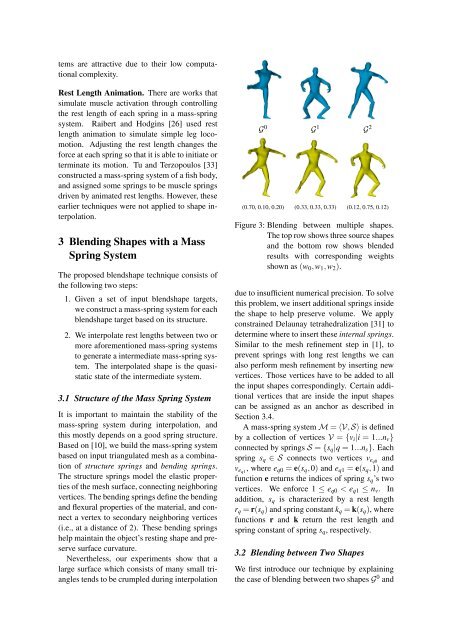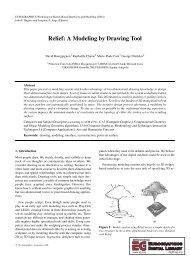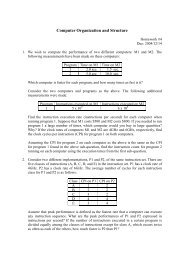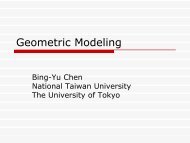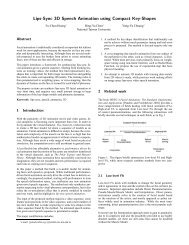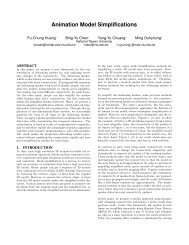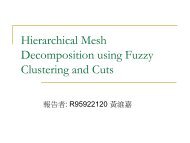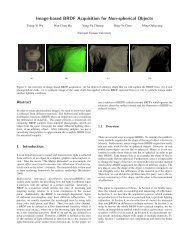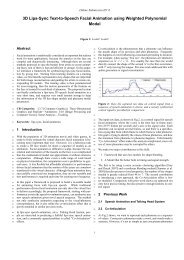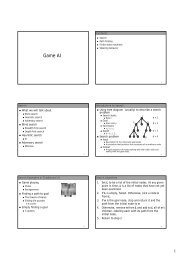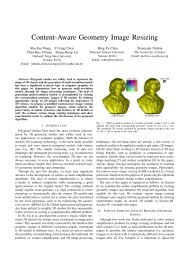A Blendshape Model that Incorporates Physical Interaction
A Blendshape Model that Incorporates Physical Interaction
A Blendshape Model that Incorporates Physical Interaction
- No tags were found...
Create successful ePaper yourself
Turn your PDF publications into a flip-book with our unique Google optimized e-Paper software.
tems are attractive due to their low computationalcomplexity.Rest Length Animation. There are works <strong>that</strong>simulate muscle activation through controllingthe rest length of each spring in a mass-springsystem. Raibert and Hodgins [26] used restlength animation to simulate simple leg locomotion.Adjusting the rest length changes theforce at each spring so <strong>that</strong> it is able to initiate orterminate its motion. Tu and Terzopoulos [33]constructed a mass-spring system of a fish body,and assigned some springs to be muscle springsdriven by animated rest lengths. However, theseearlier techniques were not applied to shape interpolation.3 Blending Shapes with a MassSpring SystemThe proposed blendshape technique consists ofthe following two steps:1. Given a set of input blendshape targets,we construct a mass-spring system for eachblendshape target based on its structure.2. We interpolate rest lengths between two ormore aforementioned mass-spring systemsto generate a intermediate mass-spring system.The interpolated shape is the quasistaticstate of the intermediate system.3.1 Structure of the Mass Spring SystemIt is important to maintain the stability of themass-spring system during interpolation, andthis mostly depends on a good spring structure.Based on [10], we build the mass-spring systembased on input triangulated mesh as a combinationof structure springs and bending springs.The structure springs model the elastic propertiesof the mesh surface, connecting neighboringvertices. The bending springs define the bendingand flexural properties of the material, and connecta vertex to secondary neighboring vertices(i.e., at a distance of 2). These bending springshelp maintain the object’s resting shape and preservesurface curvature.Nevertheless, our experiments show <strong>that</strong> alarge surface which consists of many small trianglestends to be crumpled during interpolationG 0 G 1 G 2(0.70, 0.10, 0.20) (0.33, 0.33, 0.33) (0.12, 0.75, 0.12)Figure 3: Blending between multiple shapes.The top row shows three source shapesand the bottom row shows blendedresults with corresponding weightsshown as (w 0 ,w 1 ,w 2 ).due to insufficient numerical precision. To solvethis problem, we insert additional springs insidethe shape to help preserve volume. We applyconstrained Delaunay tetrahedralization [31] todetermine where to insert these internal springs.Similar to the mesh refinement step in [1], toprevent springs with long rest lengths we canalso perform mesh refinement by inserting newvertices. Those vertices have to be added to allthe input shapes correspondingly. Certain additionalvertices <strong>that</strong> are inside the input shapescan be assigned as an anchor as described inSection 3.4.A mass-spring system M = 〈V,S〉 is definedby a collection of vertices V = {v i |i = 1...n v }connected by springs S = {s q |q = 1...n s }. Eachspring s q ∈ S connects two vertices v eq0 andv eq1 , where e q0 = e(s q ,0) and e q1 = e(s q ,1) andfunction e returns the indices of spring s q ’s twovertices. We enforce 1 ≤ e q0 < e q1 ≤ n v . Inaddition, s q is characterized by a rest lengthr q = r(s q ) and spring constant k q = k(s q ), wherefunctions r and k return the rest length andspring constant of spring s q , respectively.3.2 Blending between Two ShapesWe first introduce our technique by explainingthe case of blending between two shapes G 0 and


